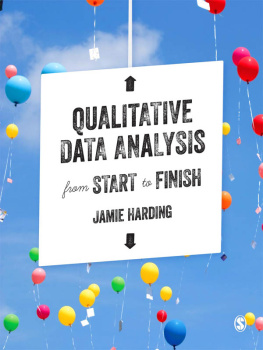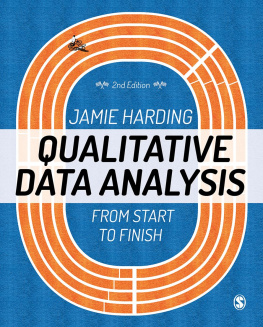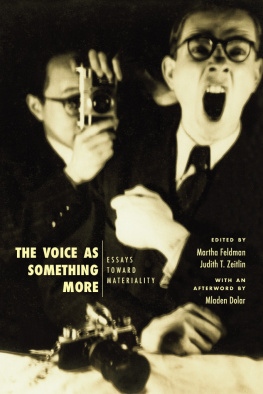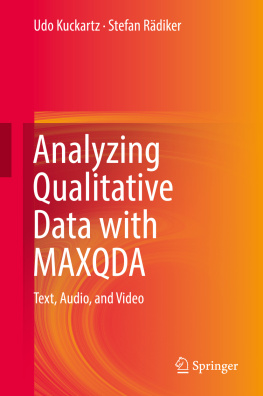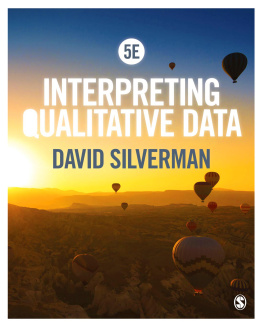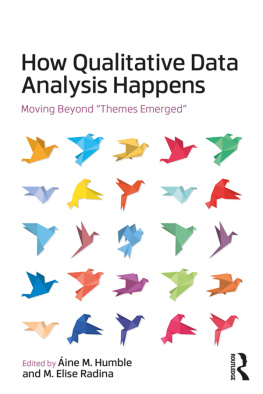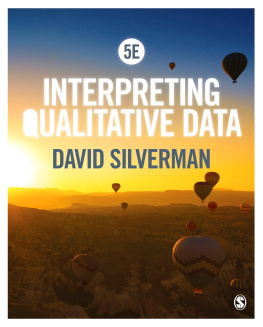STRATEGIES
FOR INTERPRETING
QUALITATIVE DATA
MARTHA S. FELDMAN
University of Michigan
Qualitative Research Methods
Volume 33
Copyright 1995 by Sage Publications, Inc.
All rights reserved. No part of this book may be reproduced or utilized in any form or by any means, electronic or mechanical, including photocopying, recording, or by any information storage and retrieval system, without permission in writing from the publisher.
For information address:
| SAGE Publications, Inc.
2455 Teller Road
Thousand Oaks, California 91320
E-mail: SAGE Publications Ltd.
6 Bonhill Street
London EC2A 4PU
United Kingdom SAGE Publications India Pvt. Ltd.
M-32 Market
Greater Kailash I
New Delhi 110 048 India |
Printed in the United States of America
Library of Congress Cataloging-in-Publication Data
Feldman, Martha S., 1953
Strategies for interpreting qualitative data / Martha S. Feldman.
p. cm. (Qualitative research methods ; v. 33)
Includes bibliographical references (p. ).
ISBN 0-8039-5915-X. ISBN 0-8039-5916-8 (pbk.)
1. Organizational sociologyResearchCase studies. 2. Social sciencesResearchCase studies. 3. Student housingMichiganManagementCase Studies. I. Title. II. Series.
HM131.F388 1995
300.72dc20
94-23071
00 01 10 9 8 7 6 5 4
Sage Production Editor: Astrid Virding
CONTENTS
SERIES EDITORS INTRODUCTION
Interpretive approaches to field data are diverse, but Martha Feldman has courageously selected four of them, ethnomethodology, semiotics, dramaturgical analysis, and deconstruction, and written a brief overview of their utility. Her presentation is made more compelling because she applies the techniques to aspects of the same body of data drawn from her long-standing and detailed study of a large university housing office. She thus contributes to the number of volumes in the series concerned with interpretive approaches to field data (Ball, Manning, Hunt, Thomas, and others).
She remains close to the data, and keeps a simple format for presenting the approaches. Since the data are from one large study, one see how various facets of a field study can be illuminated and the differential power of the approaches used to reveal answers to central theoretical questions.
In her ethnomethodological analysis, she shows how physical realities (e.g., buildings) become institutional realities and how the latter extends the meanings of the former. In the section on semiotic analyses, she shows how policies help to create the institutional realities and later uses Griemas to show how decisions are differentially perceived by participants. In her dramaturgical analysis, she demonstrates how backstage events pattern outcomes, and how decisions are made in well-nested offices deep inside large buildings. Her deconstruction of discussions of salary and reward show how elements of democracy, and equality are emphasized and hierarchy and power are suppressed. Strengths and weaknesses of the four approaches are evaluated in a final chapter.
Clearly written and well-exemplified, Feldmans book will serve well as a primer on approaches to data for qualitative analysis, whether they be undertaken as pure or applied studies done in fields such as evaluation, policy studies, or business.
Peter K. Manning
John Van Maanen
Marc L. Miller |
ACKNOWLEDGMENTS
This manuscript has developed through my teaching. I am greatly indebted to the students who have used these techniques. David Bair, Deb Bubro, Ernestine Enomoto, Clare Ginger, P. Roberto Garcia, and Greg Kelly as members of the cult club all helped me begin this work. Ernestine and Clare and Annika kerberg, Annelle Eerola, Anna Holm, Simon Holquist, Patrik Kvikant, Juha Lassila, Martin Lindell, Jan Schrder, Caroline Stenbacka, Tiina Vainio, and Niclas Whrn from my course in Finland have furthered my understanding of the techniques by their uses of them. I am grateful to Gje Sevon for giving me the opportunity to teach these techniques in Finland.
I am also grateful for the careful readings and helpful comments of Lynn Eden, Elizabeth Hansot, Kathy Knopoff, Alan Levy, Debra Meyerson, Marvin Parnes, Peter K. Manning, and John Van Maanen.
Over the years, I have learned a great deal, especially about semiotics and dramaturgy, by talking with Peter K. Manning and reading his work. My understanding of these theories owes much more to him than I can indicate through citations.
I am indebted to the members of the Housing Office at the university where I pursued my research. They gave freely of their time and knowledge so that I might gain a better understanding of their culture. Concerns about confidentiality prevent me from naming them. I am, however, extremely grateful.
I am deeply indebted to Linda McMichael who did the artwork for this book, and who helps in many ways to make my work life easier and more productive. I am similarly indebted to Hobart Taylor III who helps to make all of my life more joyful.
This book is dedicated to W. Lance Bennett, who introduced me to ethnomethodology and showed me how much fun research could be.
STRATEGIES
FOR INTERPRETING
QUALITATIVE DATA
MARTHA S. FELDMAN
University of Michigan
1. INTRODUCTION
As I sit in my office up to my eyeballs in data, I am once again impressed with the enormity of the problem of analyzing qualitative data. I have audiotapes, floppy disks, and written documents. I have my field notes and some of my students field notes. I have copies of reports and minutes of meetings. I have between 10,000 and 20,000 electronic mail messages and another 2,000-3,000 pieces of hard copy mail. I have buttons and calendars and thank you notes. It will take me several weeks working full time just to review all these materials. How am I to make sense of them?
Many people who have worked with ethnographic or other qualitative data will recognize these feelings. The task can be overwhelming. One sometimes feels that reviewing the data only reinforces the complexity and ambiguity of the setting. While it is well to remember this complexity and ambiguity, the task at hand is to create an interpretation of the setting or some feature of it to allow people who have not directly observed the phenomena to have a deeper understanding of them.
Interpretation Creation
The tricky part of this interpretation creation, of course, is to create an interpretation that is neither simply the application of some preexisting theory to your data nor only a description of how the members of a culture understand particular phenomena. Either of these is possible, but often one wants to go beyond these. By the time you have completed fieldwork, you have so much data that, if you were looking to support a particular theory, you probably could. That is not, however, the point of this research. If that is the intended goal, there are much more efficient ways to achieve it. At the same time, the goal is not only to describe a culture. Though describing a culture (or even knowing it well enough to start to describe it) is very difficult and, of course, one cannot describe a culture without also interpreting it (Clifford, 1986), people who do qualitative research are often expected to go quite a bit beyond describing what members know about the culture. The goal, it seems to me, is to develop ones own interpretation of how parts of the culture fit together or influence or relate to one another that is intrinsic to the setting one has studied and, at the same time, sheds light on how similar processes may be occurring in other settings.





